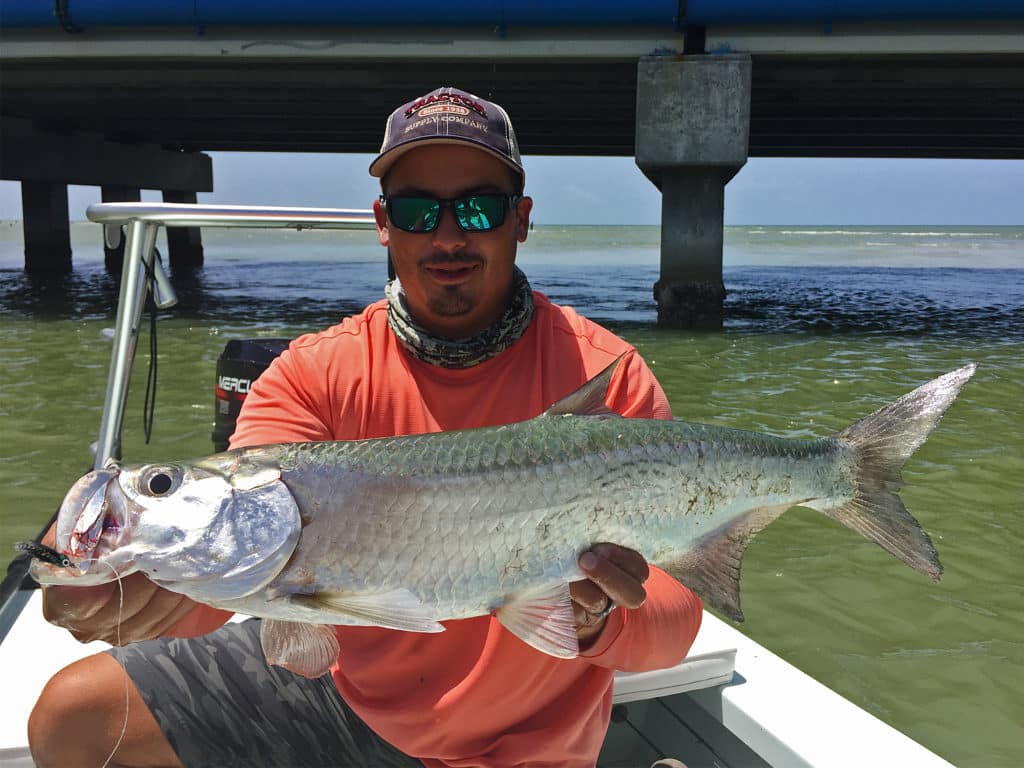
SILVER PRINCES
What jumps higher and more often than a giant tarpon, and also eats flies more willingly? A baby tarpon! Of course, baby is a relative term. Given that tarpon are known to exceed 200 pounds in weight, juvenile specimens 30 pounds and smaller are considered babies, and many fly fishers prefer to target those youngsters than to lock horns with the full-grown, triple-digit-weight monsters.
For shallow rollers, particularly those visibly feeding on minnows or shrimp on the flats, it’s a matter of getting your fly in the right spot — that small window that forces a tarpon to decide whether to eat what’s right in front or turn and go around it. That usually means leading the fish by two or three feet, making the sure the fly is right in the fish’s path of travel and starting to move away when the tarpon gets there.
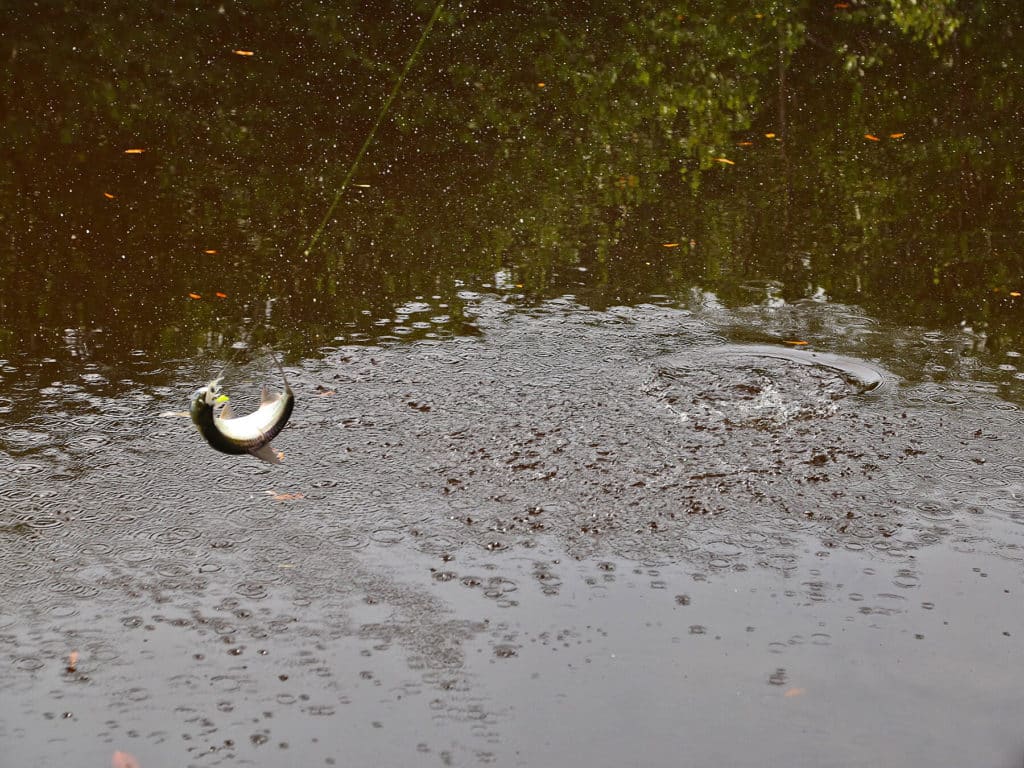
AERIAL DISPLAY
Florida estuarine waters, including shallow grass, creeks, river mouths and residential canals (be they salty, brackish or fresh), as far north as Tampa on the Gulf Coast and Daytona Beach on the Atlantic side have fishable populations of those silver princes. Though at times it seems the juveniles like to be at close to deeper water refuge, they don’t migrate hundreds of miles like the adults do. In fact, some bay tarpon are such homebodies that, once you locate a baby tarpon hole, you can expect it to continue to harbor fish in the future.
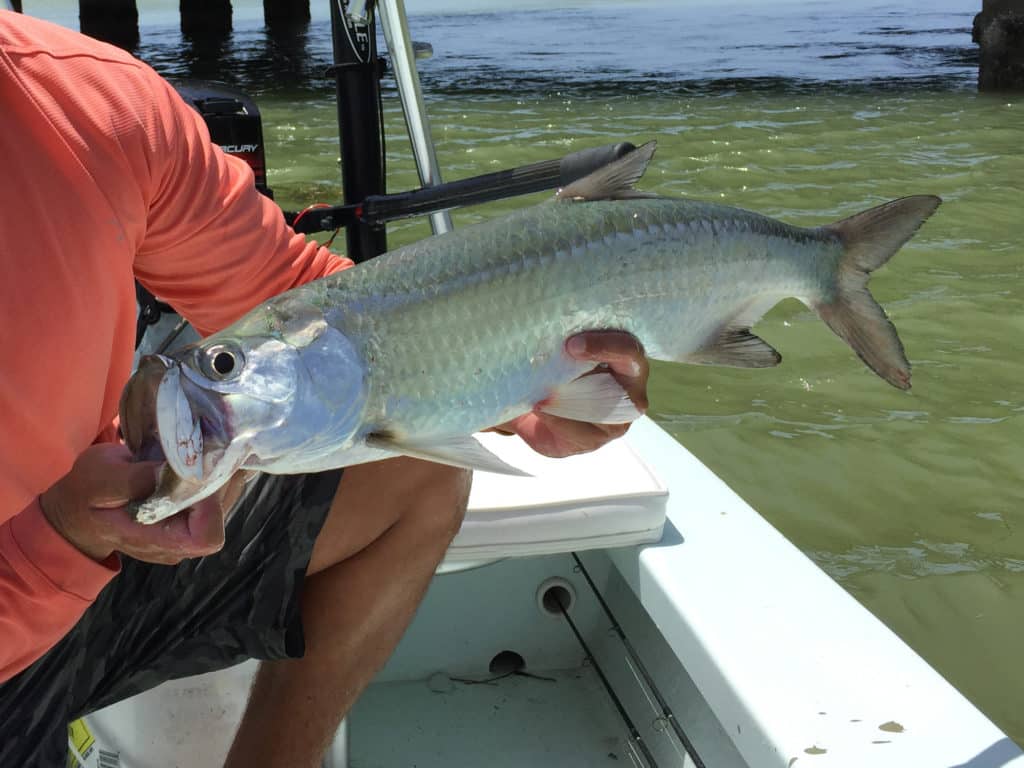
PERFECT LIGHT GEAR TARGETS
BASIC TACTICS:
As is the case with big poons, the babies’ body language will clue you in to how to fish them. Those rolling happily at the surface in the shallows are my favorite. They tend to be hungry and you have a reduced water column to work with your fly. It’s the fish in deeper creeks and canals that gulp air at the surface and then plunge back down toward the bottom with a quick tail kick that are most challenging, though not impossible to feed.
For shallow rollers, particularly those visibly feeding on minnows or shrimp on the flats, it’s a matter of getting your fly in the right spot — that small window that forces a tarpon to decide whether to eat what’s right in front or turn and go around it. That usually means leading the fish by two or three feet, making the sure the fly is right in the fish’s path of travel and starting to move away when the tarpon gets there.
Early in the morning, the fish roll more frequently. And after a hot, humid night, schools or strings of baby tarpon gulp air almost continuously. It’s a beautiful sight, typical in mid summer on Florida Bay. Hookups are almost a sure thing then, but the action wanes quickly a couple of hours after sunrise. This scenario repeats itself just before dusk.
A floating line is a best for such a situation, though a clear intermediate line greatly decreases the chance that floating grass will funnel down the line to your fly, spoiling the presentation.
The deeper fish call for dredging primarily. You can try casting with a floating line and sub-surface fly and hope that the fish come to the surface long enough to see the fly, but fishing a weighted fly deeper in the water column with a sinking line is a better bet.
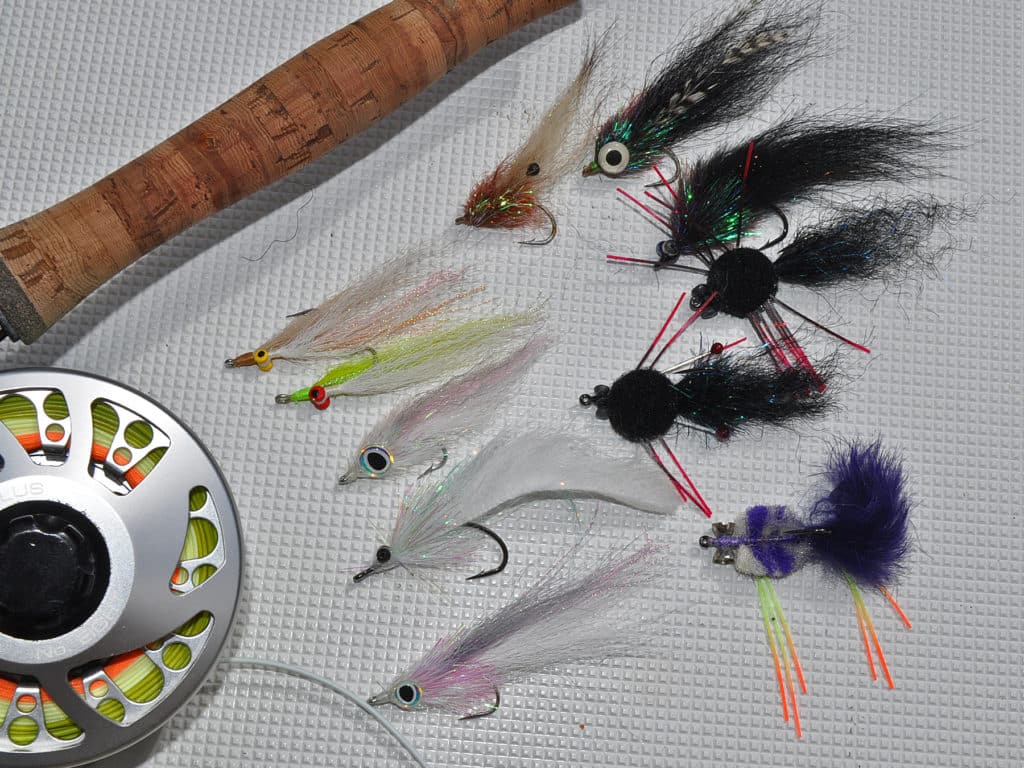
BABY TARPON ARSENAL
FLY PATTERNS:
Usually not as fussy as the more heavily fished adults, baby tarpon eagerly attack just about any fly they can fit into their bucket mouths, but they have an affinity for bushy “breather” style patterns that undulate freely with minimal manipulation from the angler.
Deer-hair muddlers and divers tied with marabou and soft, splayed hackles fall in that category and rank high on my list. They cast a wake on top of the water and, once soaked a bit, ride just below the surface film, subtly getting the fish’s attention while looking enticingly vulnerable.
A Gurgler work’s miracles some days. But don’t pop it loudly, that tends to turn the fish off. Traditional streamers, such as Seaducers and many of the popular Puglisi patterns, work well, too. Should there be floating grass on the surface, choose a fly with a weed guard or tie on a Bendback. Avoid traditional poppers, the wake a baby tarpon’s head creates just before striking pushes the fly out of the way at the last minute, resulting on missed or aborted strikes.
The location of a tarpon’s eyes (high on their head and fairly close together) and mouth (protruding lower jaw slanted upward) are best suited for ambushing prey from below, so tarpon of all sizes take flies at their same depth, or slightly above their position in the water column. Therefore, weighted flies, such as a Clouser Minnow, should only be used when fishing deep.
Color choice runs the gamut, but it’s a good bet to use dark flies over dark bottom, and switch to white, chartreuse and other light shades over sand. Grizzly hackles are desired adornments that suggest fish scales or shrimp body segments.
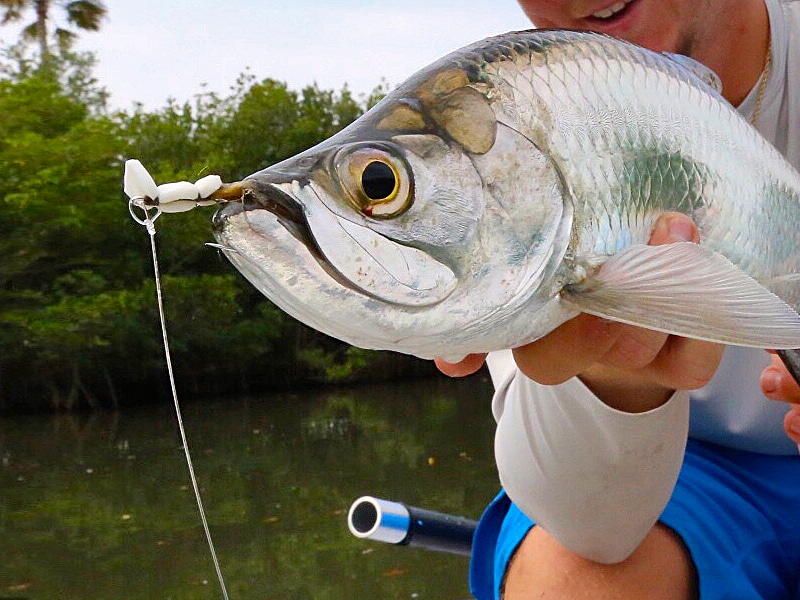
SUBTLE SEDUCTION
FRESHWATER TACTICS
Baby tarpon are perfectly at home in fresh water, often migrating into inland canals, ponds and lakes far removed from their connections to salt water. Their air bladder enables them to gulp air and thrive even in stagnant waters with low oxygen content, where they are safe from predators. The number of fish in freshwater environments seems to increase in the winter. This applies to the Everglades watershed, as well as many residential canals well inland from Central Florida to the south, but that is not always the case.
Baby tarpon are frequently more selective in fresh water, and many a fly fisher has left a canal or pond visibly loaded with fish scratching his head, wondering if they eat at all. They certainly do, but feeding often takes place mostly at night and at first light. I have targeted baby tarpon in Miami canals without success until I returned after sunset. That was the secret, after all, tarpon are notorious nocturnal feeders.
There is usually enough light pollution in most urban bodies of water to see the fish rolling at the surface, so I would simply sight cast bushy, black or purple deer hair muddlers with a good silhouette and hooked up regularly. Most fish were in the 8- to 15-pound range, but an occasional 30- to 40-pounder would claim my fly and threaten to dump my 8-weight line and the entire backing.
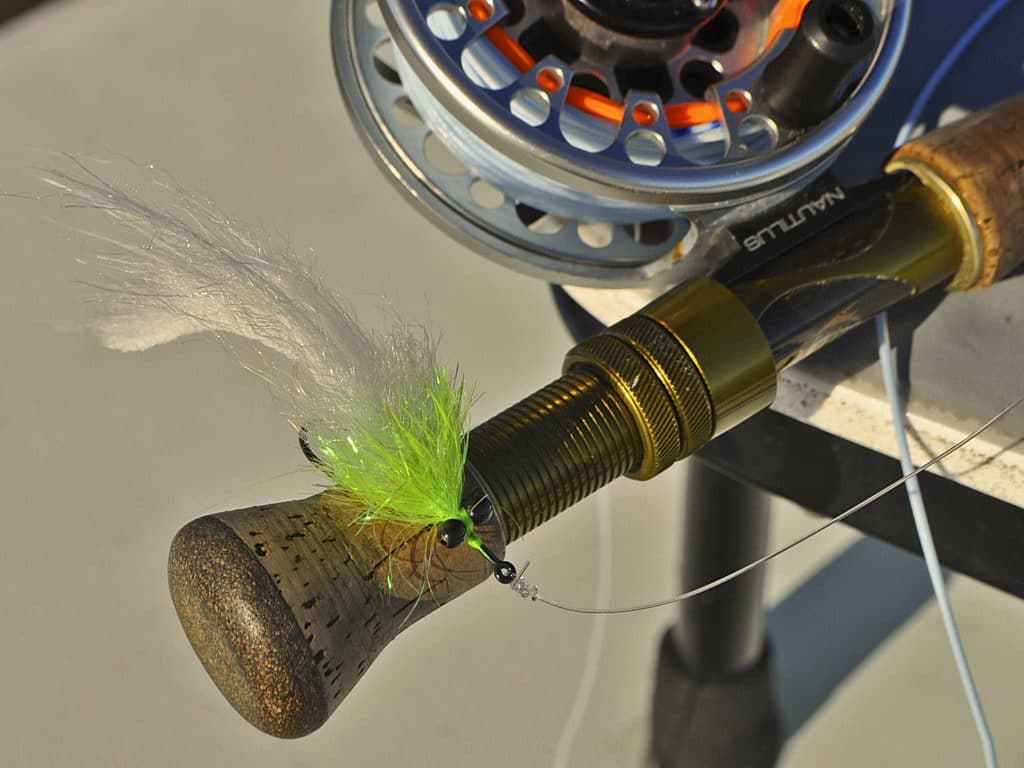
LOW LIGHT CONDITIONS
MATCHING SIZE:
Fly rods from 6- to 9-weight are ideal for baby tarpon, just let the size of both the flies and the fish you’ll be targeting dictate the tackle selection. I opt for a 9-weight when chasing 20- to 30-pounders on the flats and usually pull out my 8-weight for fish in the 10- to 15-pound class, leaving my lighter rods for single-digit-weight specimens. My 10-weight is reserved only for casting sinking flies and lines around bridges (dredging) for 30-pound fish, and when larger tarpon are around.
The latest trend is to use smaller tarpon flies (especially for wary giants that get lots of fishing pressure), with hooks 2/0 and smaller. So for the babies, I find 1/0 is a good overall choice. However, a No. 1 is often a better match for smaller flies and fish south of 10-pounds. And for small, sparse flies and little 1- or 2-pound silver princes, I go down to a No. 2 hook.
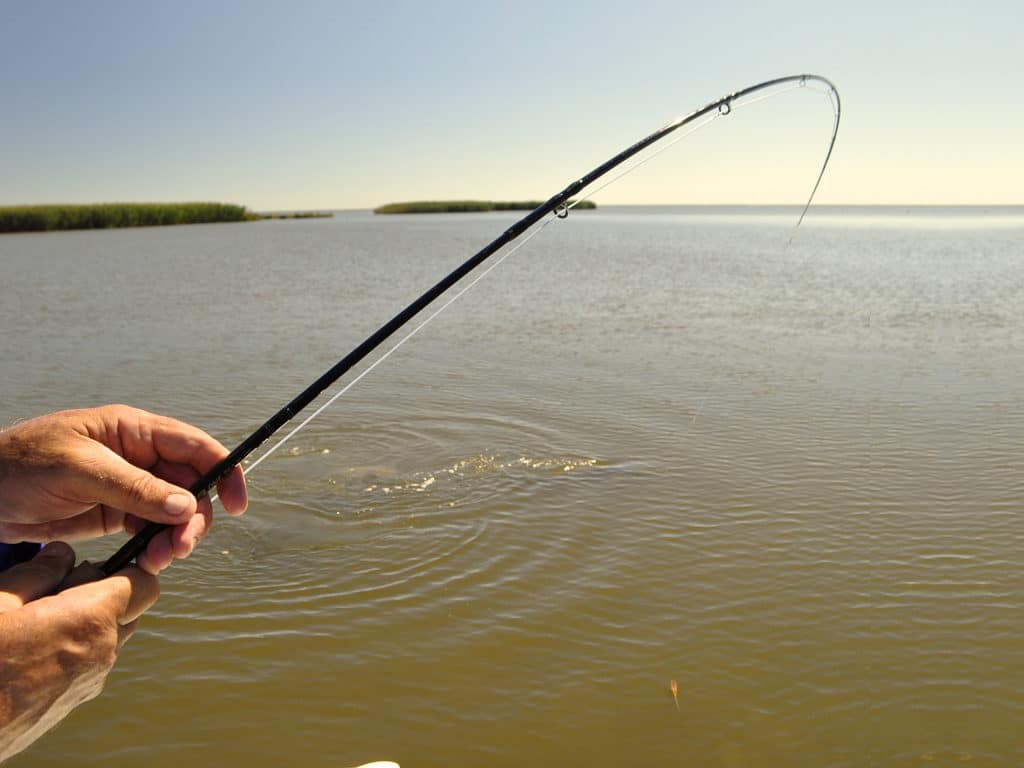
PROPER SCALE
HOOK OPTIONS
As when targeting big tarpon, fly hooks must be sharp to penetrate the fish’s hard jaws, and they must be re-sharpened after a baby tarpon throws the fly. Some anglers are playing with circle hooks with some success, but top quality J-hooks, like the Owner Aki, Gamakatsu SC 17, SC 15 and Saltwater Series, Mustad Signature C68, and Tiemco 600SP, work just fine.









